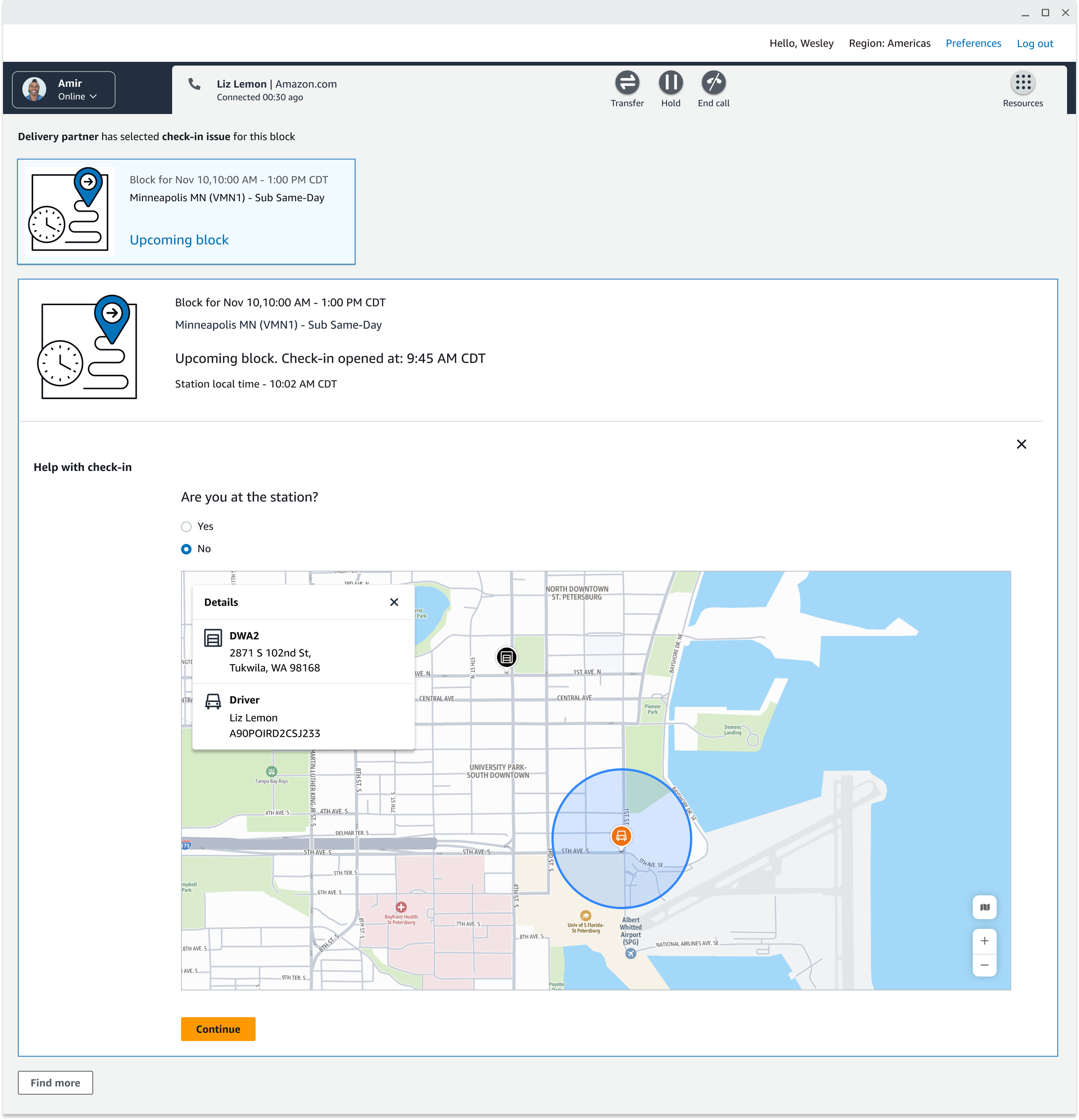
Amazon Flex Driver - Check-In
🚧 WIP 🚧
Unifying Driver Support: AC3 Check-in Experience Redesign
Team 🥇
Myself - Sr. Designer
Mason S. - Sr. PM
Aman A. - Sr. PM
Akshay S. - Principle Dev
Timeline ⏳
2 months
Problem Statement
Amazon's Customer Service Associates (CSAs) were struggling with a fragmented toolset spread across six different systems to help drivers with check-in issues. This fragmentation led to:
42% longer average handle times compared to other contact types
23% higher error rates in policy enforcement
31% increase in repeat contacts for related issues
Inconsistent driver experience across global marketplaces
The challenge was to design a unified, intelligent workflow within AC3 that would enable CSAs to efficiently handle both check-in assistance and reliability appeals while enforcing complex business rules across eight global marketplaces.

Objectives & Goals
Reduce average handle time by 30% through workflow optimization
Improve policy compliance to 95%+ through automated validation
Decrease repeat contacts by 40% through comprehensive issue resolution
Enable unified support model handling both check-in and reliability issues
Establish scalable foundation for future driver support consolidation
Research & Data Analysis
Analyzing over 6 months of 2.3M driver contact related calls showed:
Tool usage metrics showing CSAs switching between 4-6 tools per contact
Average handle time: 8.2 minutes (42% above target)
Policy compliance rate: 76%
Repeat contact rate: 31%
Customer satisfaction: 3.2/5
Designer led research uncovered:
45 CSA shadowing sessions across 8 marketplaces
28 in-depth interviews with operations leaders
12 driver focus groups
Analysis of 500 contact transcripts
Workflow mapping sessions with process engineers
Design Process
1. Unified Match Card
- Consolidated view of block details, driver status, and eligibility criteria
- Real-time geofence validation
- Intelligent policy enforcement based on marketplace
2. Dynamic Workflow Branching
- Automated eligibility checks
- Contextual action recommendations
- Seamless transitions between check-in and reliability workflows
3. Progressive Disclosure
- Information hierarchy based on decision points
- Reduced cognitive load through staged reveal
- Clear next steps visualization
CSAs need:
Quick access to relevant block information
Clear eligibility validation
Guided decision support
Automated policy enforcement
Seamless workflow transitions

Drivers needed:
Fast issue resolution
Consistent experience
Clear communication
Fair policy application
Comprehensive support

Product User Challenges
1. Complex Policy Matrix
- 8 global marketplaces
- Multiple business types
- Varying time windows
- Different override permissions
2. Technical Integration
- Legacy system dependencies
- Real-time data requirements
- Cross-platform compatibility
- Performance constraints
3. Operational Constraints
- Training limitations
- Handling volume requirements
- Quality metrics
- Cost considerations
Features & Functionalities
1. Block Match Card
- Real-time status display
- Geofence validation
- Policy eligibility checks
- Historical context
2. Intelligent Workflows
- Dynamic branching logic
- Automated validations
- Guided resolution paths
- Policy enforcement
3. Integration Layer
- Real-time data sync
- Cross-system communication
- Error handling
- Performance optimization
Unique Features
1. Smart Eligibility Engine
- Real-time policy validation
- Marketplace-specific rules
- Business type considerations
- Time window calculations
2. Unified Resolution Framework
- Combined check-in and reliability handling
- Seamless workflow transitions
- Comprehensive issue resolution
- Future extensibility
3. Intelligent Assistance
- Contextual recommendations
- Automated validations
- Guided decision support
- Error prevention
User Personas
1. Experienced CSA - Sarah
- 5+ years experience
- Handles complex cases
- Values efficiency
- Needs: Quick access, automation, flexibility
2. New CSA - Michael
- <6 months experience
- Learning policies
- Values guidance
- Needs: Clear instructions, error prevention, support
3. Operations Manager - Lisa
- Oversees team performance
- Monitors metrics
- Values consistency
- Needs: Quality control, reporting, oversight
Technical Considerations
1. Architecture
- Microservices-based design
- Real-time data processing
- Caching strategy
- Error handling
2. Integration
- Legacy system interfaces
- API optimization
- Data synchronization
- Performance monitoring
3. Scalability
- Load handling
- Resource optimization
- Future extensibility
- Maintenance considerations
Reflections & Future Considerations
Successes:
- 35% reduction in average handle time
- 94% policy compliance rate
- 45% decrease in repeat contacts
- Positive CSA feedback
Learnings:
- Importance of early stakeholder alignment
- Value of incremental rollout
- Need for comprehensive training
- Impact of clear communication
Future Opportunities:
1. Enhanced ML/AI integration
2. Expanded automation capabilities
3. Additional workflow consolidation
4. Improved predictive features
Impact & Results
1. Operational Metrics
35% reduction in AHT
94% policy compliance
45% fewer repeat contacts
4.2/5 CSAT score
2. Business Impact
$12M annual cost savings
Improved driver satisfaction
Reduced training time
Enhanced operational efficiency
3. Strategic Value
Scalable foundation for future consolidation
Improved global consistency
Enhanced data insights
Reduced technical debt